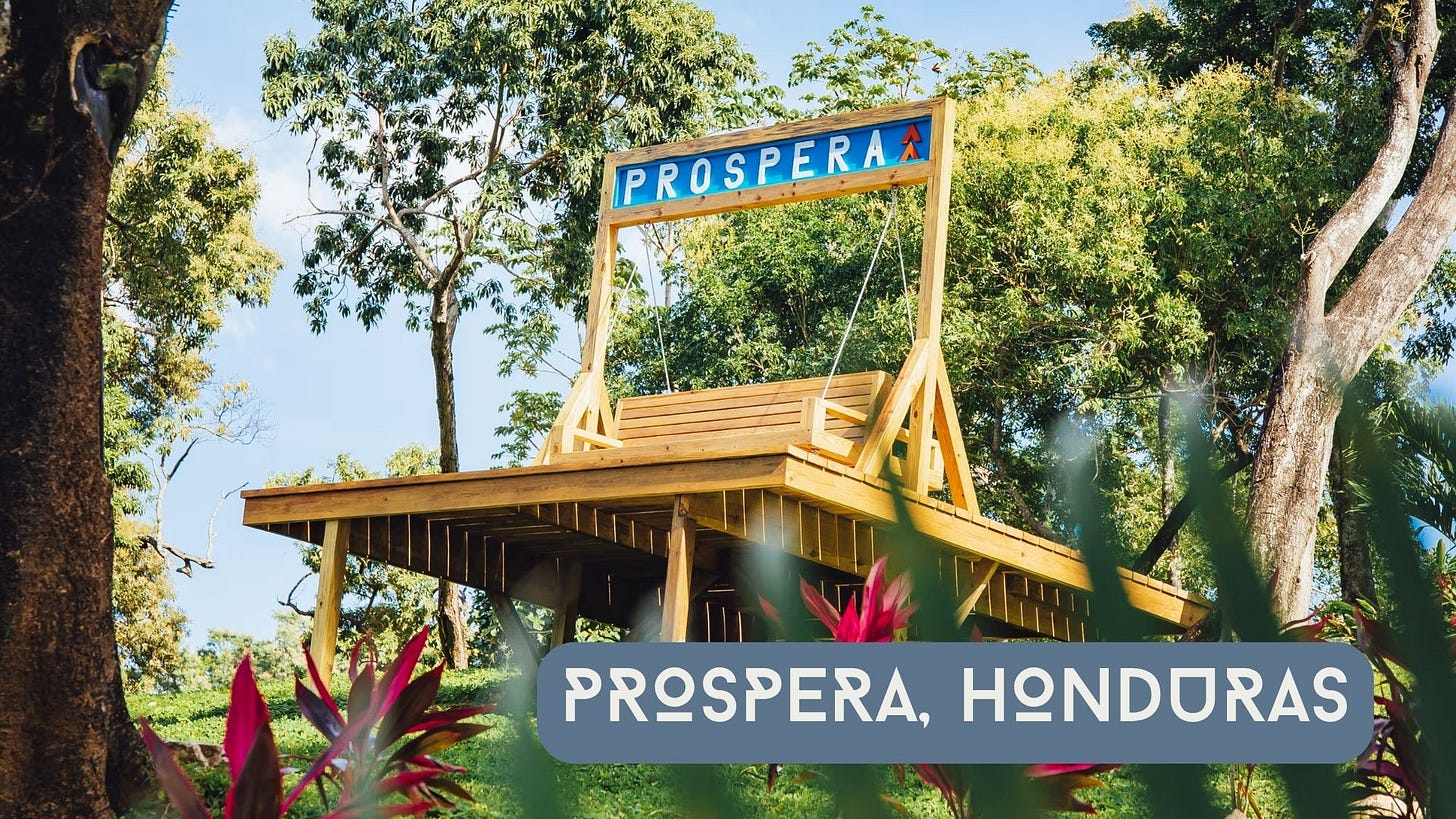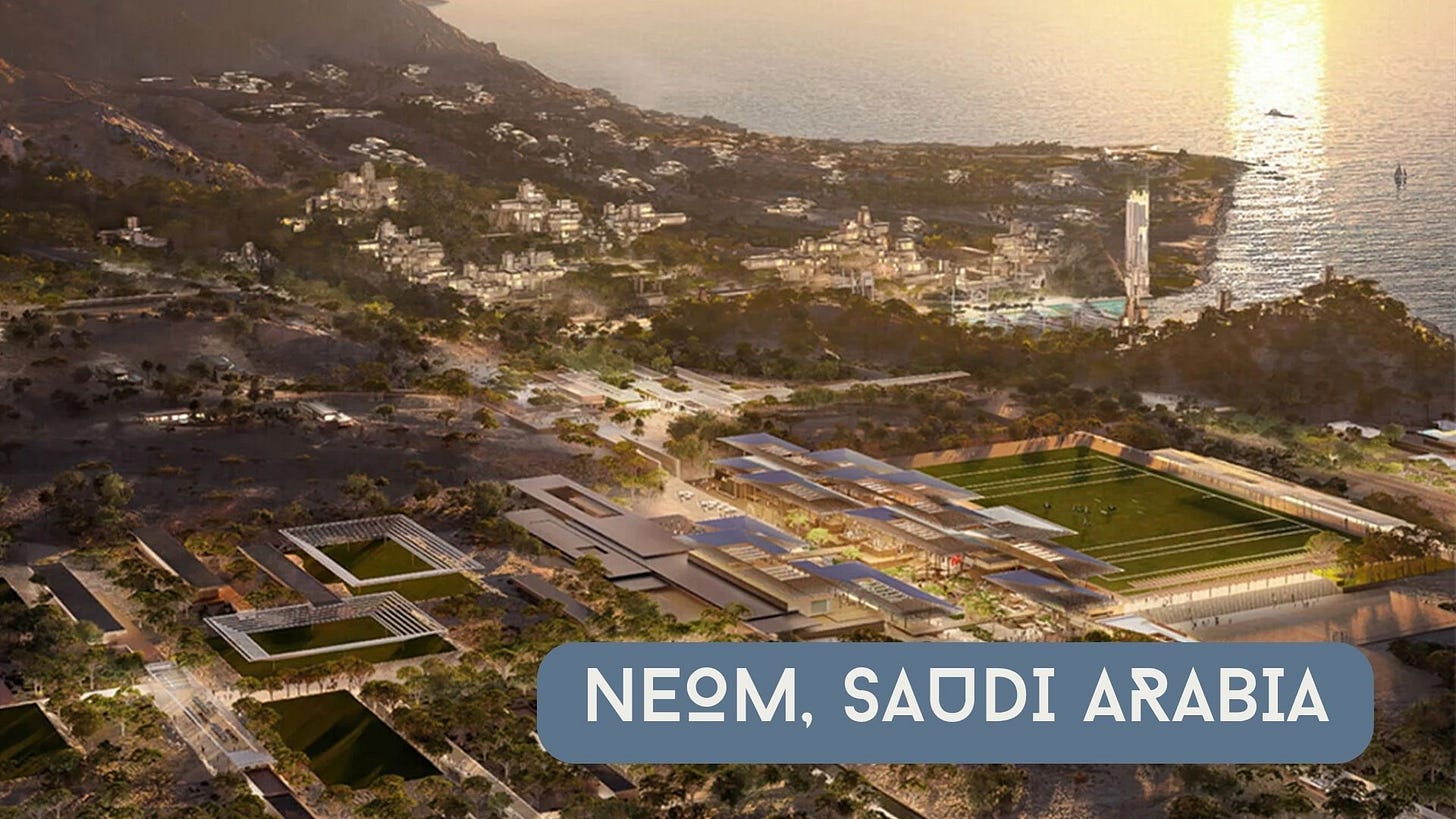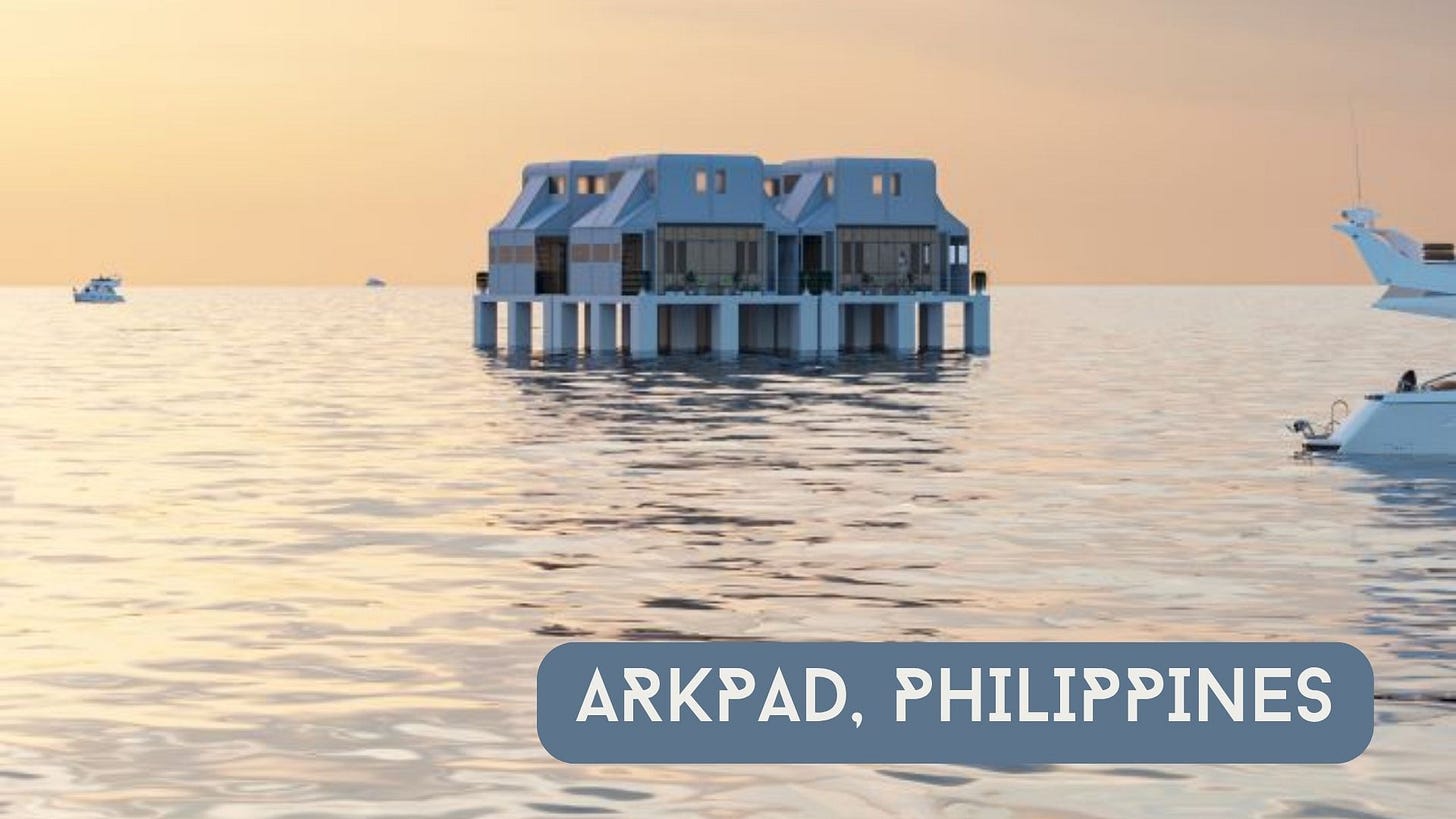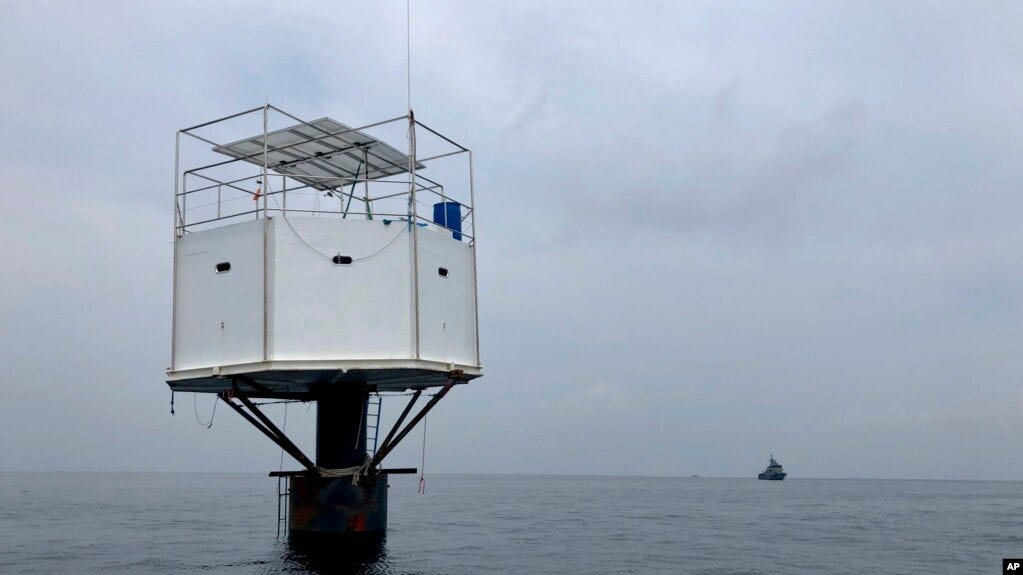These fantasy cities of the future might be your new home
The ultra-wealthy are planning your future right now. They'll call it 'utopia' and sell it to you as such, but it's actually the opposite. Welcome to the first of a two-part series.
Utopia is a place of “ideal perfection, especially in laws, government, and social conditions." At least, that’s the dictionary definition.
The thing is, despite humans having tried for thousands of years to attain Eden-esque perfection, it’s impossible. Worse, the irony of such efforts is literally baked into the word ‘utopia:’
From Merriam Webster (emphasis added):
In 1516, English humanist Sir Thomas More published a book titled Utopia, which compared social and economic conditions in Europe with those of an ideal society on an imaginary island located off the coast of the Americas. More wanted to imply that the perfect conditions on his fictional island could never really exist, so he called it "Utopia," a name he created by combining the Greek words ou ("not, no") and topos ("place").
Still, that doesn't stop people from trying to create fictional paradise. The latest attempts are — unsurprisingly — conceived of, funded by, and built by our billionaire overlords, who aim to own everything and define how our lives will be lived in the future.
At the same time, a paradox is unfolding. While several attempts at billionaire-initiated paradises are currently in the works, some efforts are failing, some are falling apart, and some are simply struggling to get off the ground.
What we know about Silicon Valley elites, bitcoin bros, and AI billionaires is that they dream big and have virtually limitless finances. So even failed attempts at utopia — or whatever their version of it is — gets the entire cohort a step closer to decoding a formula that might stick. It’s like unlimited funding to indulge a God complex.
In part one of this series, we’re looking at four concepts for creating paradise on earth crafted by the freedom loving, libertarian, optimized-living-through-technology crowd. What exactly do these communities promise? Who's behind them? And most importantly, could they just be 15-minute dystopian wolves in utopian sheep’s clothing? Let’s dive in.
1. Próspera (Honduras)
Próspera began as a bold libertarian experiment on the tropical island of Roatán, off the northern coast of Honduras. It’s the brainchild of Erick Brimen, a Venezuelan-born wealth fund manager who imagined a city run not by politicians, but by market forces and blockchain logic. He’s aiming to create a low-tax, deregulated tech haven where businesses can make their own laws, or choose to implement existing national laws from a menu of 36 countries. Residents pay low taxes (payable in Bitcoin), and biotech startups push the limits of radical life extension with experimental, as yet unproven treatments disallowed in other countries.
With venture capital backing from Coinbase and Sam Altman–linked projects, plus support from figures like Peter Thiel, Próspera has quickly become a magnet for crypto evangelists, longevity obsessives, and deregulation devotees. It hosts conferences with themes like: "Make death optional." It’s creating a walled city with private arbitration courts, judges who adjudicate online from Arizona (no idea why Arizona — our research was not explicit), and QR-code entry checkpoints.
But like all utopias, this charter city dream has clashed with reality. One critic called it a “libertarian fantasy… that’s not going to turn out well.” The Honduran government that initially supported the project and allowed for the zoning laws making it possible has since collapsed in scandal — with the former president serving time in US prison for conspiring to import and distribute over 400 tons of cocaine. That’s a lot of blow.
Locals in the nearby village of Crawfish Rock have not taken kindly to the idea of the gated city and have accused Próspera of land grabs, environmental damage, and trying to push them out. When the current democratic socialist President, Xiomara Castro, declared the former administration’s zoning laws unconstitutional, Próspera fought back in international court, demanding nearly $11 billion USD in damages — about a third of the country’s GDP — an amount that would bankrupt the country if they lose the case.
Brimen is doubling down, lobbying American politicians to argue in his favor and launching a spin-off project aimed at Africa.
This all plays out as an ironic twist of history: a 21st-century version of the banana republic, complete with foreign investors, private courts, and corporate control over land, law, and labor. The term 'banana republic' was coined by author O. Henry to describe Honduras — a place where US fruit companies ran the economy. Now, crypto-capitalists and Silicon Valley VCs are picking up where the plantations left off, except this time, they're promising immortality instead of bananas.
2. NEOM (Saudi Arabia)
NEOM was supposed to be Saudi Arabia’s leap into the future: a $500 billion high-tech oasis in the desert that would make even Silicon Valley blush. Conceived in 2017 by Crown Prince Mohammed bin Salman as the crown jewel of his Vision 2030 plan, NEOM promised flying taxis, robot dinosaurs, artificial moons, a desert ski resort with fake snow, and a 170-kilometer mirrored city called The Line.
This mirrored city was meant to stretch 170 kilometers across the desert with no cars, no roads, and no emissions — just smart infrastructure, biometric surveillance, and those previously mentioned flying taxis.
But like many utopias, the fantasy is already buckling under the weight of reality. The goal was for The Line to eventually be home to 9 million people, with 1.5 million residents by 2030. Middle East Eye reports that Saudi officials now predict fewer than 300,000 in that time frame. Only 2.4 kilometers of The Line may actually be completed by 2030. Oil revenues — the main funding source — have declined sharply, and insiders say the kingdom is facing an “environment of limited resources.” Budget reviews are underway, and other NEOM projects (like the year-round ski resort) have been shelved, delayed, or drastically scaled back.
Behind the glossy renderings lies a construction project with a dystopian work culture. NEOM’s former CEO, Nadhmi al-Nasr, developed a reputation for abusive management. “I drive everybody like a slave,” he said, celebrating “[w]hen they drop down dead… That’s how I do my projects.” In one case, he told an employee to “walk into the desert and die” so he could urinate on their grave. As a result, there has been a mass exodus of foreign executives, many of whom forfeited six-figure contracts just to escape the toxic environment.
Meanwhile, members of the Howeitat tribe, native to the land NEOM occupies, have resisted the development. Many have been forcibly removed, at least one activist was killed, and others have been imprisoned for resisting eviction. Human rights groups have condemned the project, while NEOM’s own consultants warned that the mega-structure could actually change the weather and decimate bird populations due to its massive mirrored walls.
None of this matters; Saudi officials press on. Promotional videos still promise a gleaming future where “Neomians” live in harmony with nature, technology, and robot dinosaurs. But those on the ground tell a different story — of constant surveillance, sexual harassment allegations ignored by leadership, and Orwellian control over employee life. Promises of a liberalized social zone — with alcohol, gender mixing, freedom — have quietly been walked back by a government known for its public stonings and other extreme punishment for ‘immorality.’
NEOM may, in fact, never turn out to be the future of urban life. But it may just be the world’s most expensive monument to authoritarian delusion: a dystopian nightmare of a city built on sand, surveillance, and slogans.
3. Telosa (Somewhere, USA)
Telosa is what happens when a billionaire tries to build a utopian city without using the word ‘utopia.’ Marc Lore, former Walmart executive and founder of Jet.com and Diapers.com, envisions a new city rising from scratch somewhere in the American desert (or possibly Appalachia), designed to be sustainable, walkable, tech-forward, and just equitable enough to keep you from asking too many questions.
According to Telosa’s website, this categorically, definitely, 100 percent isn’t a utopia.
Is the goal to create a utopia?
No, we are absolutely not attempting to create a utopia. Utopian projects are focused on creating a perfect, idealistic state — we are not. We are firmly grounded in reality and what is possible.
We are focused on the best, most sustainable solutions for infrastructure, urban design, economic vibrancy and city services, but we fully recognize that no solution is perfect and all human systems have flaws. Therefore, we are committed to new ideas, finding the best way to solve difficult problems and constant improvement.
And yet the renderings and promo videos suggest otherwise: gleaming towers, shaded plazas, handicap-accessible courtyards, and monorails slicing silently through eco-optimized zones. If it looks like utopia, smells like utopia, and plans to engineer human behavior like utopia — well, you do the math.
The project is called “Telosa,” from the Greek word telos — meaning “highest purpose.” Hey — stop calling it utopia!
The big idea is for 50,000 people to move to this yet-to-be-determined place by 2030 and have the population eventually grow to 5 million. Everyone lives within a short walk (15 minutes maybe?) of everything they need — a school, a park, a job (lolz!), and probably an AI wellness coach. Cars, of course, are banned. There will be solar-powered towers and vertical farms and an economy based on “equitism,” a remix of a 19th-century idea where the city itself owns the land and uses rising property values to fund social services.
But for all its lofty ideas, Telosa has yet to put a single shovel in the ground. There's no final site, no government approval, and no clear funding beyond Lore’s initial push. It’s still just a shimmering concept, a mirage sketched by a star architect (Bjarke Ingels) and floated in interviews, TED talks, and design expos.
Critics argue that if Lore really wanted to help people, he could invest in solving infrastructure problems in existing cities. Others point out that “15-minute cities” — the model Telosa clearly mirrors — have become a global flashpoint, praised by urban planners but derided by skeptics as a way to centralize control, limit movement, and monitor citizens.
So far, Telosa’s biggest achievement is that it’s really good at marketing a city that doesn’t exist. If it ever does gets built, we may finally get to ask: does a billionaire-designed city really offer freedom — or just the illusion of choice in a world where the architecture has already made the decisions for you?
4. Seasteading & Arkpad (Southeast Asia)
If you’ve ever dreamed of escaping taxes, regulations, and society itself, there’s a billionaire-funded plan for that: Seasteading — the floating libertarian fantasy that just won’t sink, no matter how many times it fails.
First floated (literally and ideologically) by the Seasteading Institute in 2008, the project was originally funded by… wait for it… Peter Thiel. He envisioned self-governing cities bobbing peacefully in international waters until backing away from the idea and stating they were “not quite feasible from an engineering perspective.”
The concept was a nation without a nation, where entrepreneurs could escape pesky things like labor laws, zoning, and democracy. In short: Silicon Valley meets Waterworld, minus the humility.
An initial prototype near Thailand ended with Thai authorities raiding the floating platform and accusing the residents of endangering national sovereignty, an offense punishable by life imprisonment or death. The couple that lived on the house boat went into hiding and the Thai navy eventually hauled away what was essentially a raft with Wi-Fi.
The broader Seasteading movement has since splintered, evolved, and — most recently — mutated into a newer project with fresher branding: Arkpad. “By building a community in the ocean, you’re not just creating a home; you’re crafting a legacy of innovation, freedom, and sustainability,” reads the marketing copy.
Arkpad bills itself as a “sovereign lifestyle project” and a “network state” — crypto-native language for the same old dream: private governance, no taxes, total control. Based in the Philippines, Arkpad is aiming to build on ocean-based platforms and create a floating community, complete with decentralized ID systems, underwater real estate, and NFTs for residency. Because, of course.
Their YouTube channel mixes crypto sermons with dreamy renderings of sleek structures rising from the sea — modern-day Noah’s Arks, minus the animals or flood, but heavy on Bitcoin and barnacles. Watch the videos carefully and you’ll see the architects’ sleek computer-generated renderings blur into the reality of what an Arkpad really is: a concrete block floating in the middle of absolutely nowhere. No word on whether they supply residents with free Dramamine.
Just like Seasteading before it, Arkpad suffers from a chronic case of reality avoidance. Engineering constraints, rising ocean temperatures, maritime law, international sovereignty, and basic logistical challenges all still exist. What’s more, these projects have always been less about freedom for all and more about escape for the few. Not everyone is invited to these floating utopias. They’re luxury lifeboats for a digital elite preparing to sail away from the consequences of the world they helped wreck.
Until further notice, Seasteading and Arkpad remain what they’ve always been: libertarian lighthouses in the fog — glowing ideals with no mooring in the real world.
Final thought: utopias always fail
Whether real or imagined, all these utopian concepts promise clean slates and high-tech harmony in their own way, plugged into the seductive guarantee of a new way to live. Blockchain ruled and perfect in efficiency, there remains only one slight problem: Reality.
History shows that when elites indulge in the fantasy of utopias, reality always gets in the way. Wealthy eccentricity is tolerable for a small group of like-minded disciples, but humans are not robots. Therefore, it’s unlikely that a utopia cooked up by some micro-dosing, immortality-seeking tech bro could ever be scaled up except through heavy reliance on surveillance, coercion, and control — where things eventually devolve into socially engineered, privacy-erasing digital prisons, wrapped in glossy marketing brochures and eco-communal delusion.
There’s also the problem of governments — they’re not into the whole competition thing. But hey, that’s not going to stop these billionaires from trying. So in part two of this series, we’ll look at some of the other ways billionaires are planning to control the future of urban living and how it might affect you.







Thanks, nice post. I´m aware of the utterly dystopian ´15 minute cities´ from following events in the UK and have witnessed first hand the truly awful results of ´Low traffic neighborhoods´ in one London borough. A forest of surveillance cameras, streets turned into a labyrinth and traffic simply funelled off into poorer, working class areas. British philosopher John Gray wrote a good book all about utopias some years back. Pol Pot, Adolf, Stalin, Jim Jones all thought they were making a better world.
These modern manifestations are merely recycled ideas that naturally occur to people who are experiencing personal growth in isolation and lack the grounding in reality as you mentioned. I’ve had many encounters with these ideas and always reached the same conclusion.